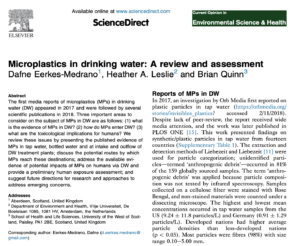This is a summary and explanation of the following research paper:
Microplastics in Drinking Water: A Review and Assessment
- Published In: Current Opinion in Environmental Science & Health
- In: Feb 2019

Key Takeaways:
- This paper is a review – it compiles and discusses findings from various studies on the presence, sources, and potential health implications of microplastics in drinking water.
- Reports of microplastics (MPs) in tap water and bottled water have been confirmed since 2017.
- Studies have detected MPs in tap water globally, with variations in concentration levels between countries. Developed countries reported higher concentrations compared to less-developed ones.
- MPs enter drinking water sources through various pathways, including environmental degradation of plastic, industrial spills, washing machine effluents, and wear and tear of plastic items in use.
Review Paper Summary
The research paper titled “Microplastics in Drinking Water: A Review and Assessment” presents a comprehensive analysis of the presence, sources, and potential human health implications of microplastics in drinking water. Here’s a summary of the key findings and discussions in the paper:
Evidence of Microplastics in Drinking Water (DW)
- Reports of microplastics (MPs) in tap water and bottled water have been confirmed since 2017.
- Studies have detected MPs in tap water globally, with variations in concentration levels between countries. Developed countries reported higher concentrations compared to less-developed ones. The majority of these particles were fibers.
- Bottled water also contains MPs, with the highest average particle counts found in samples from reusable plastic bottles. Particle sizes were predominantly small.
- Water treatment plants show varied concentrations of MPs in raw and treated water. Different methodologies have been used to identify and quantify these particles.
Sources and Pathways for Contamination
- MPs enter drinking water sources through various pathways, including environmental degradation of plastic, industrial spills, washing machine effluents, and wear and tear of plastic items in use.
- Surface waters near urban areas are commonly contaminated with MPs. Atmospheric transport is also suggested as a potential route for MPs to enter water sources.
- Wastewater treatment plants can remove a significant portion of MPs, but still, a considerable amount can enter the aquatic environment through effluents and sludge.
Implications for Human Health
- The risk characterization of MPs to humans via drinking water is not yet adequately determined due to gaps in exposure and hazard assessments.
- There is potential exposure to chemicals sorbed to MPs in drinking water. However, the contribution of MPs in drinking water to total dietary intake of environmental contaminants and additives is relatively small.
- Particle toxicity of MPs in the human body is a concern. Size, shape, and chemical composition of MPs may influence toxicological risk.
- The potential for smaller particles to translocate across the gut layer and cause tissue damage is an area requiring further investigation.
